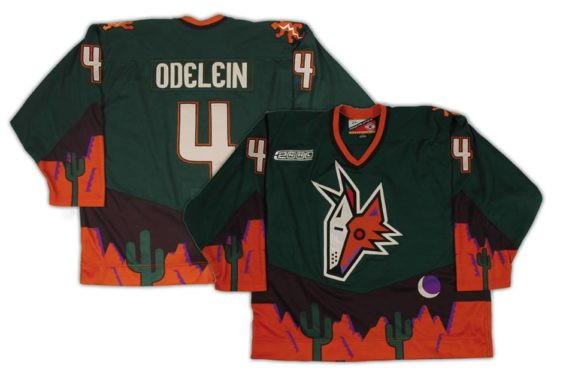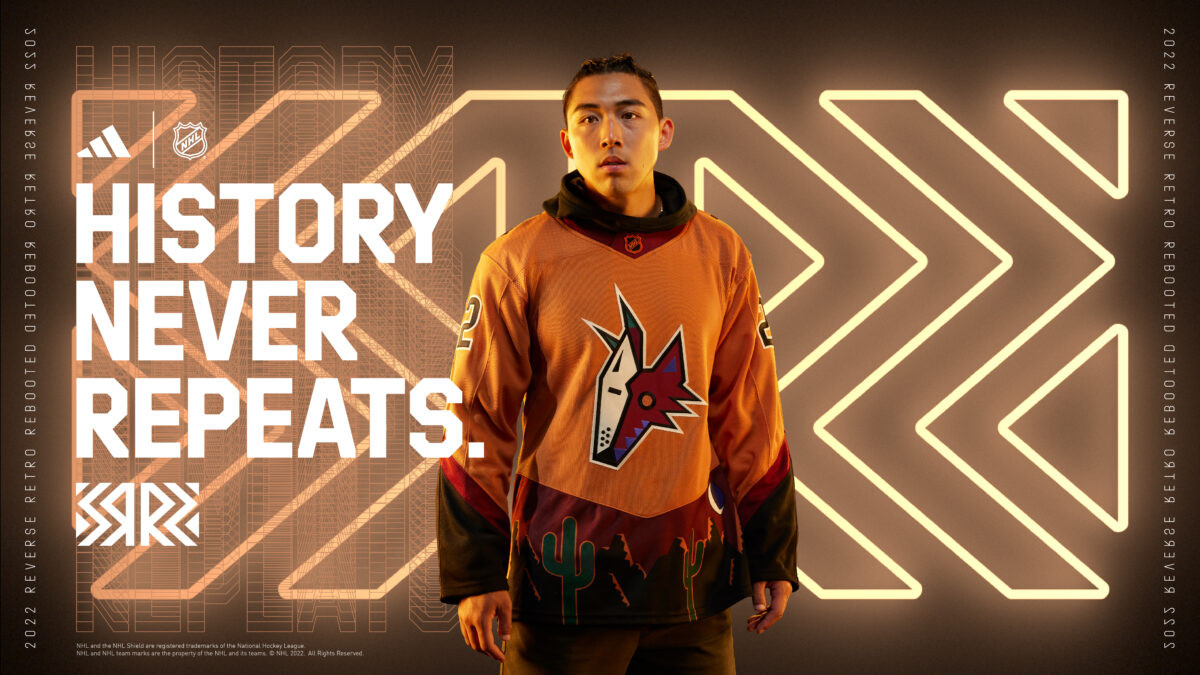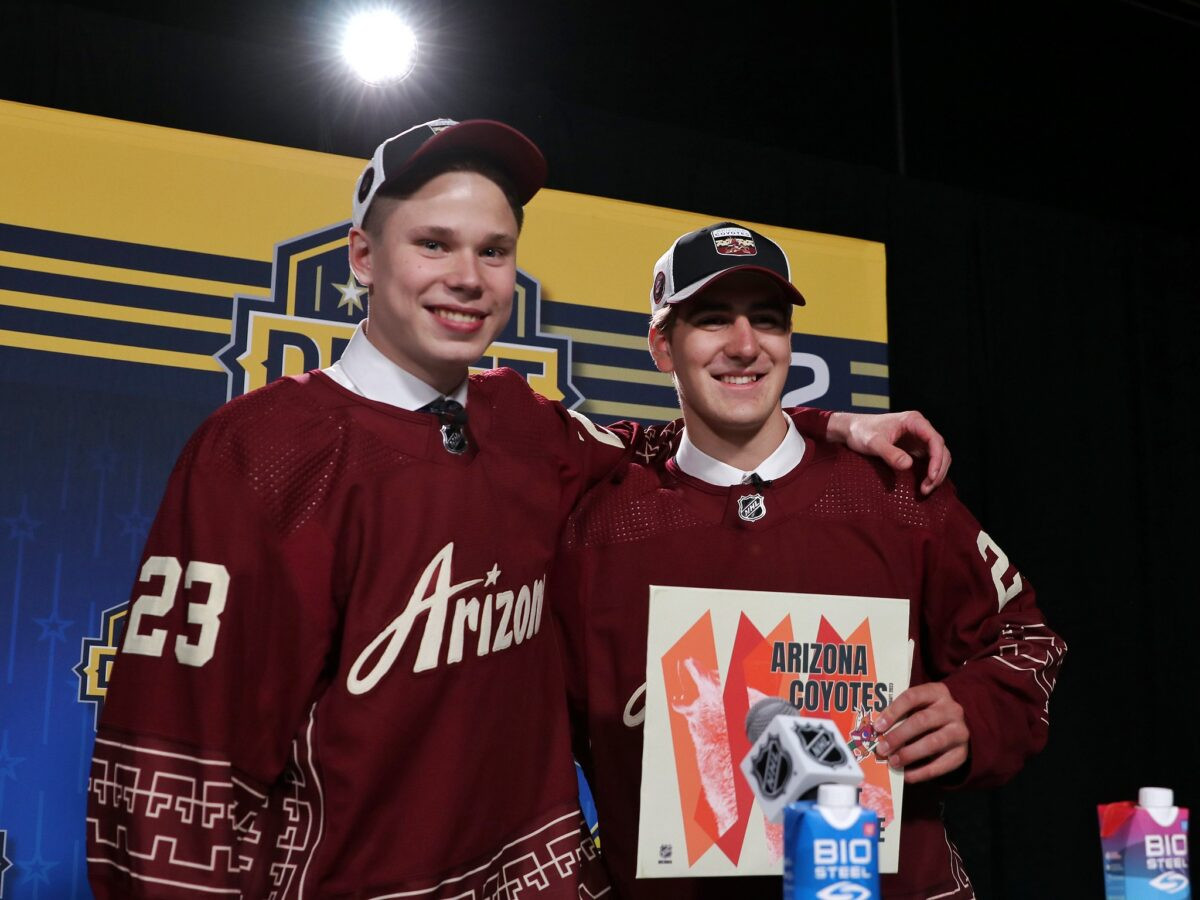The Arizona Coyotes, a franchise with a captivating history, boasts an equally compelling narrative woven through its jerseys and logos. Throughout the years, the team has undergone numerous visual identities, each reflecting a different era and design philosophy. Despite facing challenges on the ice, the Coyotes have consistently delivered when it comes to their on-ice apparel, crafting some of the most memorable and sought-after jerseys in the National Hockey League. From the legendary Kachina design to the modern flair of the Reverse Retros, the Coyotes’ jersey legacy is rich and diverse. Let’s embark on a detailed exploration of the Arizona Coyotes Uniforms, showcasing the evolution and impact of each design.
The Timeless Kachina: White & Black (1996-03, 2021-Present)
When the Winnipeg Jets relocated to Arizona and became the Coyotes, the hockey world buzzed with anticipation. Questions abounded: What would their logo be? What would their uniforms look like? Could hockey thrive in the desert Southwest? The Coyotes needed to make a bold statement, to differentiate themselves in a crowded sports landscape, and to resonate with a new fanbase. The answer was the Kachina jersey, a design that immediately captivated and continues to enchant.
Related: Arizona Coyotes Logo History
Unveiled six months before the puck dropped for the 1996-97 season, the Kachina uniform wasn’t just a jersey; it was a cultural statement. The color palette – a striking blend of forest green, brick red, sand, sienna, and purple – was unlike anything else in the NHL. At its heart was the Kachina Coyote logo, a stylized depiction of a coyote wielding a hockey stick on skates, rendered in traditional Southwestern hues. The jersey’s design was deeply inspired by Arizona’s rich Native American heritage, paying homage to the region’s history and artistry. A subtle yet ingenious detail often missed is the crescent moon within the logo, cleverly shaped to resemble a ‘C’ for Coyotes.
 Nick Schmaltz Arizona Coyotes
Nick Schmaltz Arizona Coyotes
Nick Schmaltz showcases the iconic Kachina Arizona Coyotes uniform, a design deeply rooted in Southwestern and Native American inspiration.
The Kachina made a triumphant return as the Coyotes rebranded prior to the 2021-22 season, solidifying its status as a permanent fixture in the team’s uniform rotation. Through periods of triumph and tribulation, the Kachina jersey has remained a constant, arguably the most iconic and beloved jersey in the NHL, representing a unique chapter in Arizona Coyotes uniforms history.
The Wild Desertscape Alternate (1998-03)
Riding the wave of the Kachina’s success, the Coyotes introduced another bold design shortly after their Arizona debut: the Desertscape alternate jersey. This uniform took risks to a new level, featuring a deep green base color dramatically contrasted by a vibrant desert landscape graphic wrapping around the jersey’s hem. The design included cacti, mountains, and the signature crescent moon rising in the desert sky, creating a truly unique and visually arresting jersey. It was a daring choice to feature green so prominently, but with the Kachina already established, the Coyotes seemed intent on pushing the boundaries of NHL uniform design.
Interestingly, the designer behind the Kachina and Desertscape logos had limited input on the jersey design itself. As he explained, his involvement was primarily focused on the logo elements: “The league came back to us and had us build the Coyotes mask, for that mask jersey, just the mask, not the jersey.” Adding another layer of visual interest, the Desertscape jersey featured the often-overlooked salamander logo as a shoulder patch, a subtle nod to the region’s wildlife.
 Coyotes Alternate Jersey
Coyotes Alternate Jersey
The Arizona Coyotes Desertscape alternate jersey, nicknamed “Coyote Ugly” or “Peyote Coyote” by some fans, showcases a bold and unconventional design featuring a desert scene.
Despite its striking appearance, the Desertscape jersey received mixed reviews from fans, earning nicknames like “Coyote Ugly” and “Peyote Coyote,” suggesting it wasn’t universally embraced. In terms of player comfort, early versions of the Kachina and Desertscape jerseys also presented challenges. Stan Wilson, the Coyotes’ equipment manager, noted: “Oh, for sure, without question it’s the Kachina now, back when we originally wore it, the design of it, the actual material was tough. It absorbed so much water, so it was so heavy, the originals that we wore back in the 90s. The new ones now, they’re all built with the new technology so they’re so much better. The guys love them, the players … they would wear it all of the time if they could.” After seven seasons with the Kachina as the primary jersey, the Coyotes organization opted for a significant rebrand, ushering in a new visual era for Arizona Coyotes uniforms.
The Reebok Edge Era: White & Red Howling Coyote (2003-14)
In 2003, coinciding with the team’s move to the newly built Jobbing.com arena, the Coyotes underwent a complete organizational rebrand, including a significant overhaul of their uniforms. In retrospect, this decision to move away from the Kachina as the primary jersey is viewed by many fans as a misstep. The new home and away jerseys were considerably more conventional than their predecessors, adopting a color scheme of brick red, sand, black, and white. The central logo shifted to a howling coyote head, a departure from the unique Kachina figure.
 Shane Doan Coyotes
Shane Doan Coyotes
Shane Doan, a long-time captain of the Phoenix Coyotes, is pictured wearing the red Howling Coyote jersey, which served as the team’s primary uniform for over a decade.
Despite their simpler design compared to the Kachina era Arizona Coyotes uniforms, these jerseys became synonymous with a significant period in Coyotes history, including their most successful playoff runs. The team wore these uniforms during the 2012 playoff season, culminating in a Western Conference Final appearance against the Los Angeles Kings. However, for many fans, these jerseys lacked the distinctive character of the Kachina and ultimately served as a less memorable chapter in the team’s uniform evolution. Similar to the 1990s, the Coyotes also introduced an alternate jersey during this period to inject more personality into their on-ice look.
The Energetic Running Coyote Alternate (2008-14)
Five years after the 2003 rebrand, the Coyotes introduced a new alternate jersey, their first since the Desertscape. With the howling coyote head logo now established as the primary mark, the team sought an alternate design that would complement the main uniforms. The result was the Running Coyote alternate jersey, featuring a full-bodied coyote in motion.
 Arizona Coyotes
Arizona Coyotes
An Arizona Coyotes player sporting the Running Coyote alternate jersey, a design that offered a dynamic full-body depiction of the team’s mascot.
This jersey presented a more dynamic and complete depiction of the coyote mascot compared to the head logo, offering a welcome contrast to the relatively understated red and white primary Arizona Coyotes uniforms of that time. The Running Coyote alternate was generally well-received by fans and remained a popular choice, even after its discontinuation following the 2013-14 season. It’s still a common sight at Mullett Arena among fans who appreciate this design.
Refreshed Howling Coyote: White & Red (2015-21)
This era for the Coyotes was marked by significant challenges, including arena uncertainties and on-ice struggles. Shortly after officially changing their name from the Phoenix Coyotes to the Arizona Coyotes, the team once again tweaked their uniforms.
 Clayton Keller Arizona Coyotes
Clayton Keller Arizona Coyotes
Clayton Keller, a key player for the Arizona Coyotes, wearing the updated red Howling Coyote jersey introduced in 2015, featuring a richer, desert-inspired red hue.
These updated Arizona Coyotes uniforms, while still based on the Howling Coyote theme, brought a renewed vibrancy to the design. The red color adopted was richer and deeper, evoking the tones of the desert landscape and offering a stronger visual impact compared to the preceding Reebok Edge jerseys. While these uniforms lasted only six seasons, they were seen as an improvement over the previous iteration, providing a more distinctive look that resonated with the team’s desert identity.
Reverse Retro Tributes: Purple & Sienna (2021 & 2022-23)
The NHL’s Reverse Retro program, launched to celebrate team histories through reimagined classic jerseys, provided a perfect opportunity for the Coyotes to tap into their rich uniform heritage. For the initial Reverse Retro release, the Coyotes delivered a striking tribute to the 1998 Desertscape jersey, but with a bold color twist: purple. Retaining the Peyote Coyote logo and the desert landscape hem design, the purple Reverse Retro injected a fresh and vibrant energy into a familiar design. While the purple color was widely praised, some fans found the contrast with the desert landscape graphic somewhat less cohesive than the original.
 Arizona Coyotes 2022-23 Reverse Retro
Arizona Coyotes 2022-23 Reverse Retro
The Arizona Coyotes 2022-23 Reverse Retro jersey in desert sienna, a fan-favorite design that beautifully blends classic elements with a unique color palette.
In the second wave of Reverse Retro jerseys for the 2022-23 season, the Coyotes revisited the Desertscape theme, this time opting for a desert sienna color base. This iteration proved to be a resounding success with both fans and players. Coyotes President & CEO Xavier A. Gutierrez enthusiastically announced, “We are extremely excited to introduce our new desert Sienna Reverse Retro alternate jersey. Our fans loved our purple Reverse Retro jersey, and we are confident that they will also be impressed with the cool changes to this classic jersey – especially the unique color that was inspired from our Kachina head logo. This is a great opportunity for us to grow our brand with a new and innovative jersey and connect with our Coyotes fans and our fans in waiting. We can’t wait to see our players wear these incredible jerseys at Mullett Arena.” The desert sienna Reverse Retro beautifully captured the essence of Arizona Coyotes uniforms history while introducing a fresh and appealing color palette.
Modern Minimalism: Desert Night (2022-Present)
In stark contrast to the bolder, more colorful jerseys of their past, the Coyotes introduced a new third jersey, the Desert Night uniform, for the 2022-23 season. This design embraced a more minimalist aesthetic, featuring a burgundy base color, reminiscent of the brick red in the Kachina palette. The Desert Night jersey was worn 14 times in its debut season and continues to serve as the Coyotes’ alternate jersey entering the 2023-24 season.
 Daniil But Dmitri Simashev Arizona Coyotes
Daniil But Dmitri Simashev Arizona Coyotes
Daniil But and Dmitri Simashev, the Coyotes’ first-round draft picks, proudly wear the Desert Night alternate jersey, a modern and minimalist design inspired by Arizona’s cultural roots.
The Desert Night jersey received significant promotion, notably at the 2023 NHL Draft, where first-round picks Dmitri Simashev and Daniil But donned the jersey after being selected. Designer Rhuigi Villaseñor explained his inspiration: “My inspiration for the third jersey came from the environment, the community, the colors, and the clay – roots of the AZ Culture. I feel honored to pioneer with the Coyotes the reimagining of the sport alongside culture and design.” The Desert Night jersey represents a contemporary addition to the Arizona Coyotes uniforms lineage, blending cultural inspiration with a modern design sensibility.
Arizona Coyotes Uniforms: A Legacy of Distinctiveness
The Arizona Coyotes have undeniably built one of the most fascinating and diverse jersey histories in the NHL. The Kachina jersey remains an enduring symbol not just for the Coyotes, but for the state of Arizona itself. It stands as one of the most recognizable and iconic jerseys in all of sports. Coupled with newer designs like the Desert Night and the popular Reverse Retros, the Coyotes continue to demonstrate a commitment to unique and visually compelling Arizona Coyotes uniforms. While the classic Kachina will always hold a special place, the Coyotes’ ongoing jersey evolution ensures their on-ice look remains as dynamic and captivating as their franchise history.

